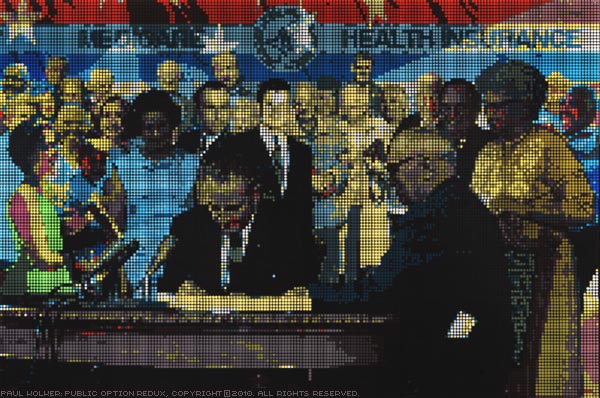
Paul Kolker: public option redux, 2010, acrylic on canvas 132 x 198 inches
In the Summer 1965, the talk in the doctor’s dining room at the Brigham was about the new healthcare reform; Medicare and Medicaid. Kolker remembers the New York Times article with the photograph depicting President Johnson (LBJ) handing a Medicare card to former president Harry Truman, that served as inspiration for Kolker’s large scale painting, Public Option Redux, depicted above. Kolker also remembers how little we understood the Medicare and Medicaid laws as recorded in the Federal Register in 1965; and how the rule of law evolved over the years with bundling of diagnosis and procedure codes, use of the resource based relative value system and acuity indices; and all sorts of other legal strategies to game the system. What was great, Kolker reminds us in that painting, is that every senior who retired from her job, which paid her healthcare insurance costs in lieu of wages when she was working, still had healthcare insurance during old age paid for in part by her Social Security monthly benefits and her and her employer’s matching contributions. That portion of Social Security benefits that was used to pay the Medicare insurance premium was the healthcare insurance for the elderly’s equivalent to the Affordable Care Act (ACA) individual mandate.
Kolker completed his Chief Residency in General Surgery at LIJ, New Hyde Park, NY in 1967 and trained in Thoracic and Cardiovascular Surgery at Mayo Clinic, Rochester, MN from 1967 through 1969. He has practiced his specialty forty-three years, from 1969 through 2012, and is now Emeritus Chief of Cardiothoracic Surgery, North Shore/ LIJ at Glen Cove Hospital, Glen Cove, NY.
In 1989 Dr. Kolker earned a JD degree from Hofstra Law School, Uniondale, NY. In 1995 he founded, along with others, a provider owned HMO, MDNY, and served as president and chairman of the holding company of physician shareholders, and as a director of MDNY through 2008.
Dr. Kolker has a wide spectrum of understanding and intuitive feelings related to American healthcare as he both studied and practiced within the system for fifty-eight years. When asked what he liked about the ACA of 2010, he answered, referencing particular works in the exhibition…
“Finally, America has a federal law, the ACA, which enables insurance companies licensed in each of the states to provide health insurance for all. Although the wheels of progress turn slowly, ultimately everyone will be covered under a health insurance contract.
Today, in a country with a 2012 United States census of 313 million, about 50 million have no health insurance. In our city of 8.3 million, 1.1 million New Yorkers are uninsured and 3.25 million are on Medicaid.
For an insurance exchange model to work, everyone must be covered and for all health risks. Steering the body and mind through a lifelong journey is like driving a car; an individual must have insurance coverage to afford to do both. The individual mandate for health insurance is now black letter law, upheld by the US Supreme Court, and subject to a penalty to give it clout.
As to why we keep calling the new health insurance law the Affordable Care Act; just think about a single emergency department visit for trauma. When you learn that the cost for such care may be double your annual health insurance premium, you may realize that it is the insurance paradigm that makes the best American healthcare affordable!”
